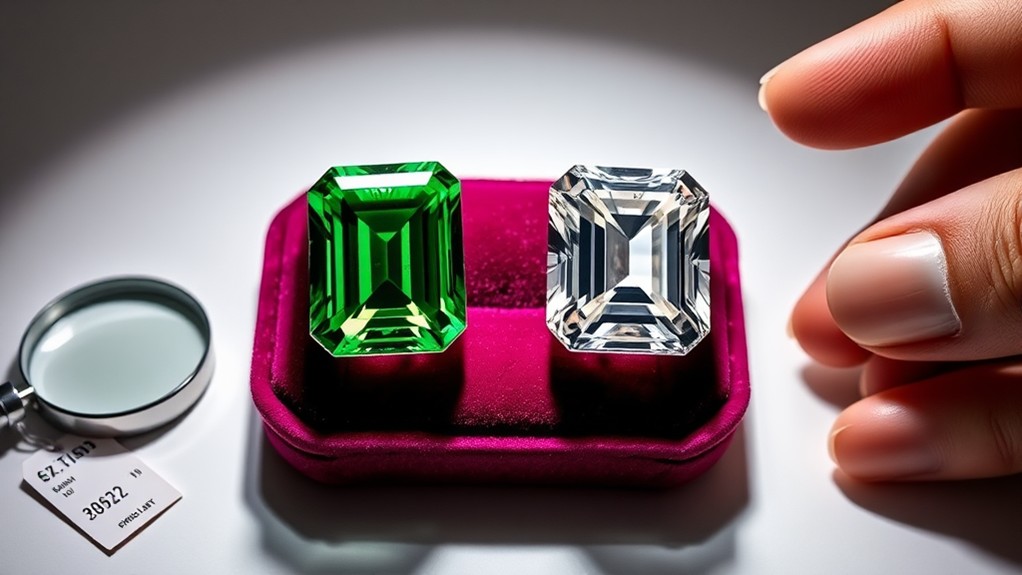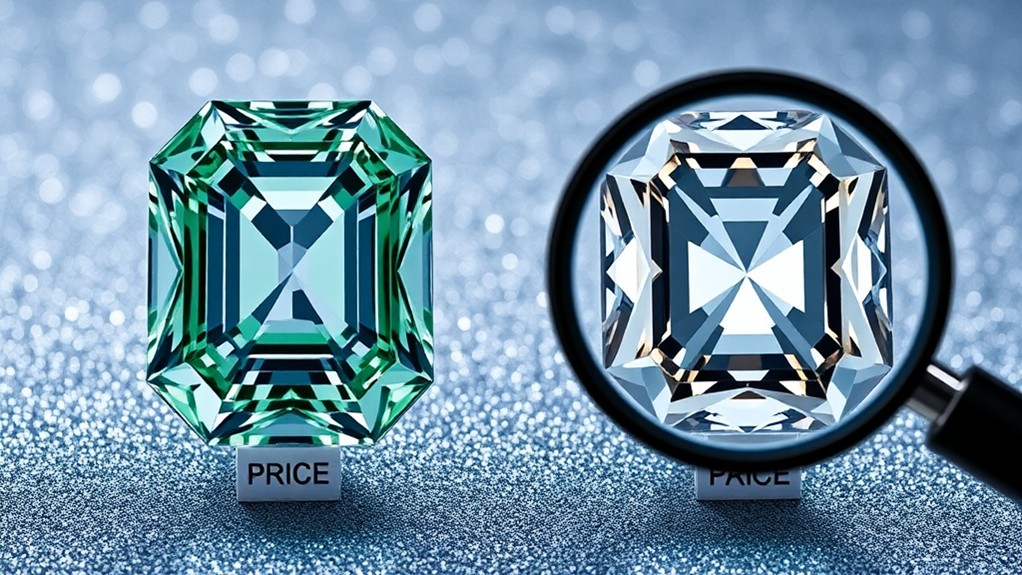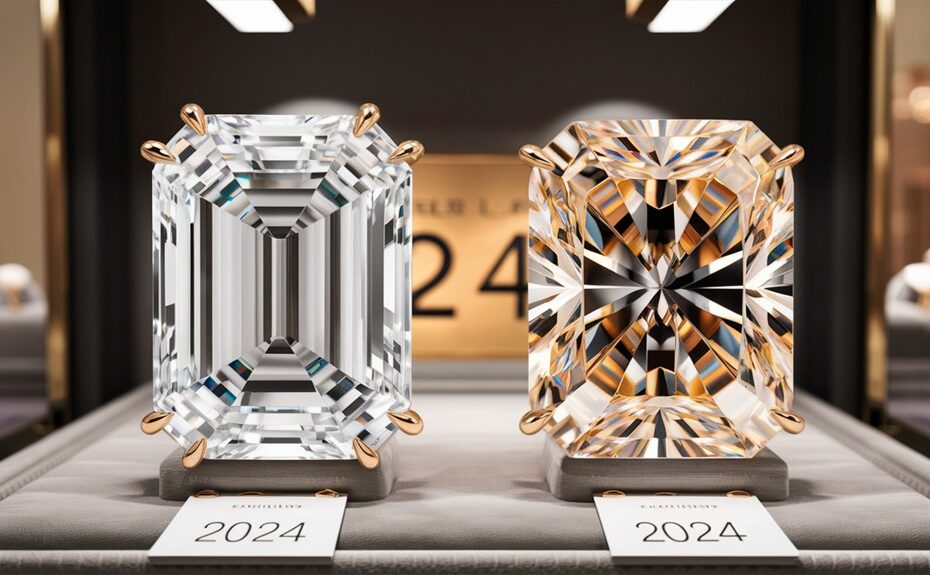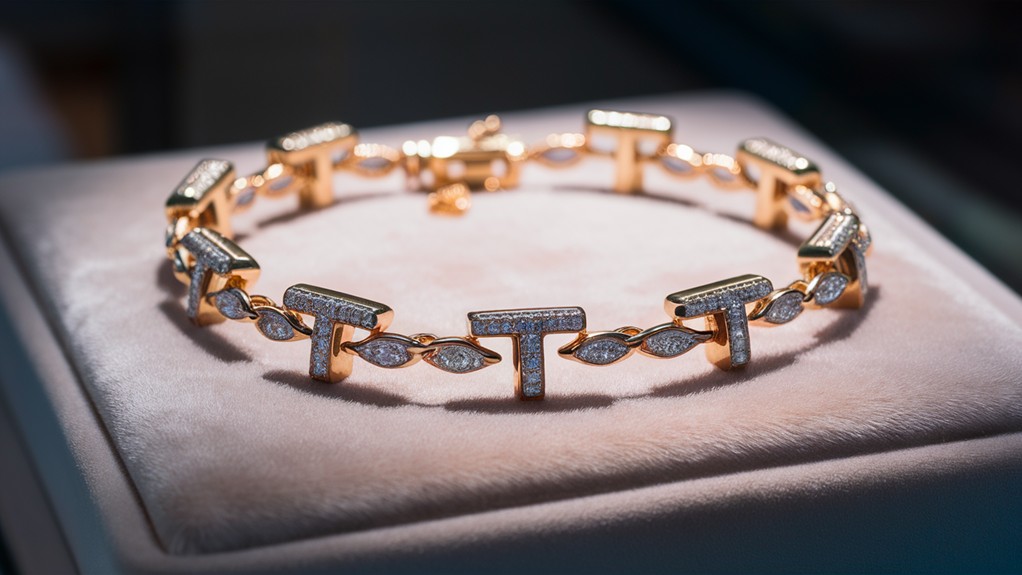When you're in the market for a diamond, you'll quickly realize that shape plays an essential role in both aesthetics and price. In 2024, the emerald and radiant cuts stand out as popular choices, each offering unique characteristics and value propositions. As you evaluate your options, you'll find that these two cuts present an intriguing cost comparison, with implications for both your budget and personal style. Understanding the factors behind their pricing can help you make an informed decision, but there's more to reflect on than just the bottom line. What hidden aspects of these cuts might affect your choice?
Our Highlighted Points
- Radiant cuts typically cost 10-30% more than emerald cuts due to intricate faceting and higher demand.
- Emerald cuts offer better value, with 1-carat stones averaging $2,800 compared to $3,000 for radiant cuts.
- Clarity requirements influence costs, with emerald cuts needing higher grades due to their open table design.
- Both cuts provide good value by retaining significant rough diamond during cutting.
- Market trends suggest increasing popularity and potential price increases for radiant cuts in 2024.
Emerald and Radiant Cut Basics

Diamonds, the epitome of luxury, come in diverse shapes, with emerald and radiant cuts being two popular choices. These diamond shapes offer distinct characteristics that cater to different aesthetic preferences in engagement rings. For those who prefer a more classic and timeless look, the emerald cut offers a unique elegance and sophistication. On the other hand, the radiant cut provides a stunning display of brilliance and fire with its numerous facets. Additionally, the tiffany novo cushion cuts have gained popularity for their romantic and soft appearance, making them a top choice for romantic celebrations. Ultimately, the diverse array of diamond shapes allows individuals to find the perfect fit for their personal style and preferences.
The emerald cut, with its rectangular shape and 57 parallel step-cut surfaces, creates a classic hall-of-mirrors effect. Originating in the 16th century, it gained popularity during the Art Deco period.
In contrast, the radiant cut, developed in the 1970s, combines step-cut and brilliant surfaces, typically featuring over 70 surfaces for greater sparkle and fire.
When considering clarity, emerald cuts require higher grades (usually VS2 and above) because of their open table design, which can expose inclusions.
Radiant cuts, however, mask inclusions better, allowing for SI1 or SI2 clarity grades.
Pricing differs between these cuts:
- Emerald cuts tend to be more budget-friendly.
- Radiant cuts generally command higher prices because of intricate faceting and demand.
Both shapes can visually elongate fingers, offering unique appeal.
When choosing between emerald and radiant cuts, consider:
- Personal style preferences
- Desired level of brilliance
- Budget constraints
- Clarity requirements
Price Factors for Diamond Shapes
When comparing emerald and radiant cut diamonds, understanding the factors that influence their prices is key to making an informed decision. Several elements contribute to the cost of these diamond shapes:
- Cut quality: Radiant cut diamonds typically command higher prices owing to their intricate cutting, which improves their brilliance and fire.
- Clarity grades: Emerald cuts require higher clarity grades (VS2 and above) as a result of their large, open table that easily reveals inclusions. This impacts their pricing compared to radiant cuts, which can mask imperfections more effectively.
- Carat weight: Both cuts are influenced by carat weight, with larger stones generally costing more per carat.
- Overall diamond quality: Color, cut precision, and symmetry all play roles in determining the final price.
When comparing prices, you'll find that emerald cut diamonds often offer better value for money, typically costing 10%-30% less than comparable radiant cuts.
For instance, a 1.00 carat emerald cut averages around $2,370, while a similar radiant cut may exceed $3,000.
However, radiant cuts generally provide superior brilliance for the same specifications, which may justify the higher cost for some buyers.
Cost Comparison and Analysis

Diving into the cost comparison between radiant and emerald cut diamonds, you'll find notable differences that can impact your purchasing decision.
The pricing comparison reveals that radiant cut diamonds generally command a higher price point, with 1-carat stones typically costing around $3,000, while emerald cuts can be found for approximately $2,800. This cost difference of about $200 arises from several factors:
- Cut efficiency: Radiant cuts retain more rough diamond during cutting, contributing to their higher price.
- Clarity grades: Emerald cuts require higher clarity grades (VS2 or above) because of their step-cut aspect, which reveals inclusions more readily.
- Inclusion masking: Radiant cuts' intricate faceting pattern better conceals inclusions, allowing for lower clarity grades (SI1) to be acceptable.
For budget-conscious buyers, emerald cuts offer a more affordable option, with pricing ranging from $2,050 to $2,479 for 1-carat stones.
However, the increasing demand for radiant cuts, driven by their combination of brilliance and elegance, may justify the higher price for some consumers.
When conducting your value analysis, consider these factors alongside your personal preferences and budget constraints.
Value Considerations for Buyers
Understanding the value proposition of radiant and emerald cut diamonds is key for savvy buyers. When conducting a diamond shape price comparison, consider these factors:
- Clarity requirements:
- Emerald cuts need higher clarity grades (VS2 and above) because of their large open table.
- Radiant cut diamonds can accommodate lower clarity grades (SI1 or SI2) while maintaining a visually appealing look.
- Budget considerations:
- Emerald cuts are often more budget-friendly, allowing for lower color grades without compromising beauty.
- Radiant cuts typically command higher prices but offer flexibility in clarity selection.
- Value for money:
- Both cuts retain significant rough diamond during cutting, providing excellent value.
- Prices for 1-carat diamonds range from $2,050 to $2,479 for both shapes.
- Personal preference:
- Emerald cuts offer elegance and potential cost savings.
- Radiant cuts provide brilliance that can improve perceived value.
When making your decision, weigh these factors against your personal preferences and budget constraints.
Both cuts offer unique advantages, allowing you to find the perfect balance between aesthetics and total costs in your diamond purchase.
Market Trends and Predictions

As the diamond market evolves, radiant and emerald cuts are experiencing shifting dynamics in popularity and pricing. You'll find that nearly one-third of engagement rings now feature fancy shapes, including radiant and emerald cuts, reflecting a significant shift in consumer tastes.
This trend is likely to continue, with radiant cuts potentially seeing increased demand and pricing in the coming years.
When comparing these diamond shapes, consider the following factors:
- Price: Radiant cuts currently command higher prices, averaging above $3,000 for a 1-carat stone compared to around $2,800 for emerald cuts.
- Clarity: Emerald cuts require higher clarity grades because of their step-cut aspects, making them more budget-friendly for lower quality stones.
- Availability: As online retailers like James Allen and Blue Nile expand their offerings, you'll have greater access to both cuts, potentially affecting market pricing dynamics.
As you investigate your options, keep in mind that the growing acceptance of fancy shapes may impact future pricing and availability.
The emphasis on unique diamond shapes is expected to continue, with radiant cuts potentially seeing increased popularity and price fluctuations compared to emerald cuts in the near future.
Frequently Asked Questions
What Is More Expensive, Emerald Cut or Radiant Cut?
You'll generally find radiant cut diamonds to be more expensive than emerald cuts. They're known for their intricate aspects and higher demand. While prices vary based on quality, radiant cuts often command a premium of several hundred dollars.
Which Diamond Shape Is Most Affordable?
You'll find emerald cut diamonds are generally more affordable. They're often less expensive than radiant cuts because of their simpler cutting. However, you should consider clarity grades, as emerald cuts require higher clarity for optimal appearance.
What Diamond Shape Holds the Most Value?
You'll find that round brilliant diamonds hold the most value. They're consistently in high demand and retain their worth well. However, if you're looking for better value for money, consider alternative shapes like radiant or emerald cuts.
Does Shape Affect Diamond Prices?
Yes, shape greatly affects diamond prices. You'll find that intricate cuts like radiant tend to cost more because of their brilliance and demand. Simpler shapes like emerald cuts are often less expensive, offering potential savings for your budget.


